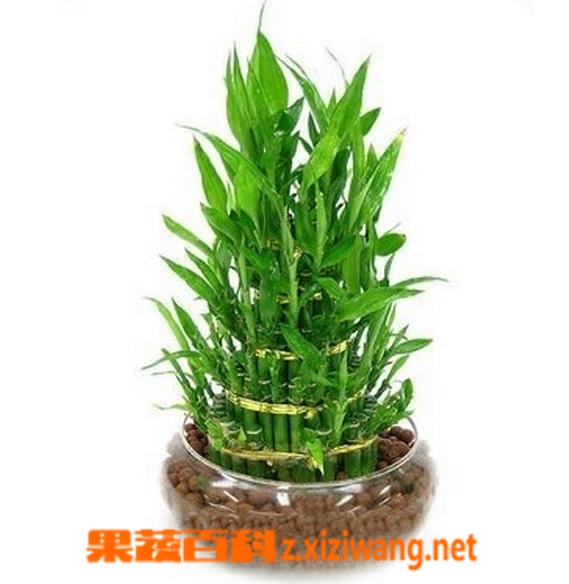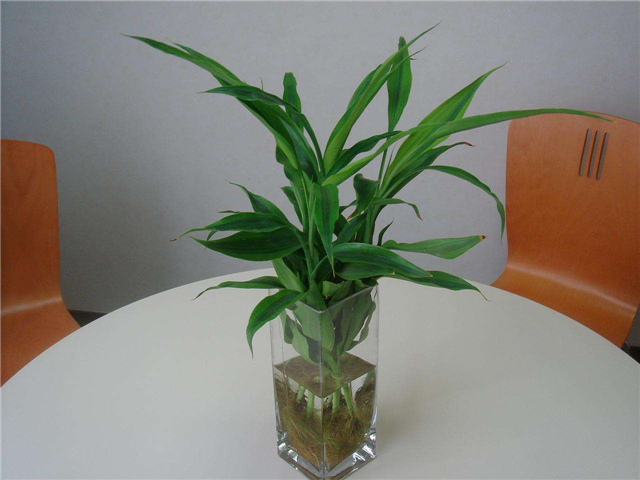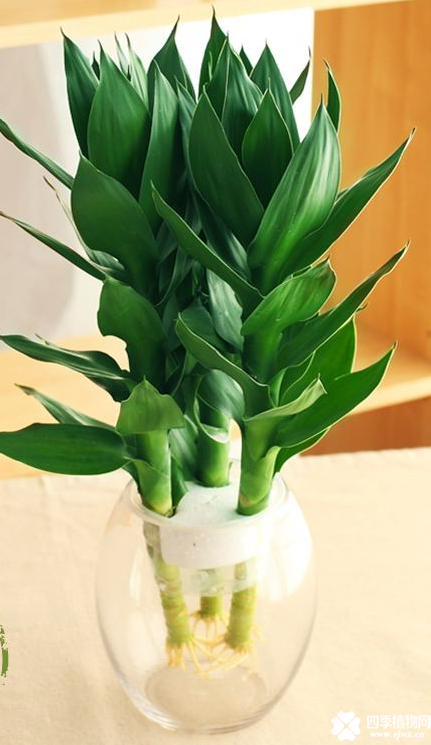The cultivation method of Fugui bamboo
Fugui bamboo is an evergreen ornamental plant of Liliaceae. Because of its thick green leaves, strong growth and easy water cultivation, Fugui bamboo has become a popular foliage plant at present, which can be used for potted and hydroponic cultivation, especially the tower-shaped planting spread from Taiwan. It is named "Kaiyunzhu" and is deeply loved by consumers at home and abroad. In Guangdong, Zhanjiang and Hainan, it has been planted in a large area as an industry, and some of the products have been exported to foreign countries.
Fugui bamboo likes high temperature, high humidity environment, shade resistance and waterlogging resistance. The suitable growth temperature is 29 ℃ ~ 30 ℃, and it can withstand 3 true low temperatures, so it can be cultivated directly in the field in southern Guangdong and Hainan provinces, but it needs shade, especially in summer and autumn.
Rich bamboo is often propagated by cutting and ramet. Every Internode of Phyllostachys pubescens is easy to root and cuttage to survive. In large-scale production, side branches or top branch shears abandoned as "open bamboo" can be used to grow cuttings of 15 cm to 20 cm, insert coarse sand or semi-silt in the field, bury 2-3 nodes in the soil, keep them moist, and take root in 35-45 days.
When planting in the field, you can choose deep and fertile sandy soil for border planting. The width of the border is 1.5m, the ridge height is 20cm to 30cm, the row spacing is 25cm, and the plant spacing is 20cm. Generally, 13000 ~ 16000 plants can be planted per mu. When the cuttings take root, N: P: K is 20:20:20 compound fertilizer or mature farm manure every 15 days to promote the branches to be stout and luxuriant, loosen the soil properly and remove weeds in time. In the growing season, 30-35kg compound fertilizer with less nitrogen fertilizer and more phosphorus and potassium fertilizer was applied per mu to promote plant growth and prevent lodging.
Planting methods of rich bamboos
Fugui bamboo is a kind of plant that everyone likes very much. its name is very likable, and its shape is fresh and natural. Rich bamboo is more likely to use the method of water culture, but in fact, soil culture can also be carried out. Next we will introduce to you the planting method of rich bamboo.

Planting methods of rich bamboos
First, the planting method of rich bamboo-- water sample.
First of all, rich bamboo water culture has certain requirements for temperature. Rich bamboo is a plant that can endure cold, but the suitable temperature for growth is between 20 and 28 degrees. If the temperature is too low, freezing damage will occur. The second is the rich bamboo lions like shade plants, too much light is disadvantageous to them, do not expose them too much in the sun. The water quality requirements of Fugui bamboo are relatively simple, do not directly use tap water, choose filtered water is better. Water sample rich bamboo can choose to match the fertilizer, every two weeks when the water can be fertilized.
Second, the planting method of rich bamboo-- soil culture.
The growth temperature of Fugui bamboo is the same as that of water culture, that is, we should pay attention to the fact that the temperature is not too low in winter so as to cause frost damage. If the rich bamboo soil is raised, the soil needs to be kept moist and watered every 3 days. If the basin soil is too dry, it will enrich the bamboo.
The leaves turn yellow. Rich bamboo can choose to spray the leaves with a spray can to cool down and increase moisture at the same time. Rich bamboo light should not be too much, followed by the best planting time is between April and September, when rich bamboo is the most suitable for rooting and development.
Cultivation methods and cultivation techniques of Phyllostachys pubescens
Pictures and information materials of Fugui bamboo: http://hua.fengqiaoju.com/duoniansheng/fuguizhu/
Fugui bamboo, also known as Xiandalong Blood Tree, has a message of "blooming wealth, bamboo reporting peace" in China. Bamboo stems and leaves are delicate, soft and elegant, so they are loved by people. How to maintain the rich bamboo? This paper introduces the culture method of rich bamboo.
Fugui bamboo is a small evergreen tree of Liliaceae. The beauty of rich bamboo is inseparable from its auspicious name. It has slender and chic leaves, emerald green leaf color, its stem nodes show the characteristics of bamboo nodes, but it is not a real bamboo.
In China, there is a message that "the flowers are rich and the bamboo is safe". Because the stems and leaves of the rich bamboo are delicate, graceful and full of bamboo rhyme, they are very popular with people. Rich bamboo has extensive management, few diseases and insect pests, easy to cultivate, and symbolizes "good luck".
Rich bamboo is suitable for small potted plants, used to decorate rooms, study, living room and other places, can be placed on the desk, coffee table and table, rich and elegant, exquisite and chic, has a good ornamental.
Fugui bamboo is native to the Cana Islands and tropical regions of Africa and Asia. In the early 1980s, it was introduced into Zhanjiang, Guangdong Province by the Tropical crop Research Institute of Chinese Academy of Tropical Agricultural Sciences.
Fugui bamboo likes high temperature and humidity environment, light requirements are not strict, Xiguang can also be shady, can be kept indoors for a long time without sunshine, do not need deliberate maintenance, as long as there is enough water to grow exuberantly.
When potted bamboos are cultivated in the house, humidity and temperature should be well controlled in management and protection. The growing season should often keep the basin soil moist, and often spray water to the leaves, in order to maintain high environmental humidity, too dry can easily lead to leaf tip dryness. Winter basin soil should not be too damp, but should often spray water to the leaves, and pay attention to cold prevention work, so as to avoid leaf yellowing, atrophy and even shedding. From May to September in the peak growing season, granular compound fertilizer can be applied 2-3 times a month to keep the leaves green and bright.
Fugui bamboo due to poor branching ability, when used as indoor ornamental, it is best to put more than 5 branches together into a pot, the effect will be better. Indoor aging for a long time, although the growth has been stable, it is inevitable that the leaves will be stained with a layer of dust, the leaves can be washed with water spray to make them show a beautiful luster again.
What if the rich bamboo leaves turn yellow:
Water yellow
The young leaves were dark yellow and dull, the old leaves had no obvious change, the branches were small yellow-green, and the new shoots shrunk not long, indicating that they were overwatered. Remove the flowers from the pot and place them in a ventilated, cool, self-drying soil mass and then put them back into the basin.
The yellow with lack of water is different from the yellow with more water, the yellow with lack of water is withered and dry at the tip or edge of the leaf, and the old leaves wither and fall off from the bottom up, but the growth of the new leaves is relatively normal. Pay attention to watering enough and thoroughly.
Strong sunlight shines directly on some shade-loving flowers (such as hanging orchids, hairpins, etc.), which can easily lead to withered leaf tips and leaf edges, and macular spots in the sunny part of the leaves. Just move to the shade.
Put in shade environment for a long time, the leaves can not get enough sunlight, can not form chlorophyll, the whole leaves turn yellow and then fall off, supplementary light can avoid the disease.
The yellowing of flowers caused by excessive fertilization or excessive concentration is shown in the dry brown on the tip of the new leaves, the leaves are generally thick and without luster, and the concave and convex are not stretched, and the old leaves are scorched yellow and fall off. Fertilizer should be stopped immediately and some fertilizers should be washed with a large amount of washing.
The performance is that the color of the young leaves becomes lighter, showing yellow or light green, while the old leaves are more normal or gradually change from green to yellow. Check the basin soil, if there is a dry phenomenon should change the soil, usually apply thin fertilizer frequently and timely pour some alum (Fugui bamboo is foliage plants should be nitrogen-based fertilizer). Note another reason for the yellowing of leaves is lack of iron. You can buy some ferrous sulfate and put it in the water according to the instructions. The easiest way is to find two small iron nails and put them in the water (preferably rusty nails).
- Prev

How to cultivate rich bamboo
Fugui bamboo is first cultivated by cutting leaves, which is used as a material for flower arrangement. Potted plants and aquaculture are becoming more and more popular now, and they are popular in the market because of their auspicious name. The rich bamboo is evergreen all the year round, and its stems and leaves are quite like green bamboo, chic, tall and straight, elegant and refined. As a small potted plant, it is suitable to be arranged in the study, living room, etc.
- Next

The method of cultivating Rich and valuable Bamboo in Water
Rich bamboo is graceful and graceful, its stems and leaves are quite like green bamboo, evergreen in winter and summer, bringing people a sense of wealth and auspiciousness. Rich bamboo water insertion is very easy to root, very suitable for hydroponic culture. Before entering the bottle, the ① should cut off the leaves at the base of the cuttings and cut the base into an oblique notch with a sharp knife. The incision should be smooth to facilitate the absorption of water and nutrients.
Related
- Fuxing push coffee new agricultural production and marketing class: lack of small-scale processing plants
- Jujube rice field leisure farm deep ploughing Yilan for five years to create a space for organic food and play
- Nongyu Farm-A trial of organic papaya for brave women with advanced technology
- Four points for attention in the prevention and control of diseases and insect pests of edible fungi
- How to add nutrient solution to Edible Fungi
- Is there any good way to control edible fungus mites?
- Open Inoculation Technology of Edible Fungi
- Is there any clever way to use fertilizer for edible fungus in winter?
- What agents are used to kill the pathogens of edible fungi in the mushroom shed?
- Rapid drying of Edible Fungi

